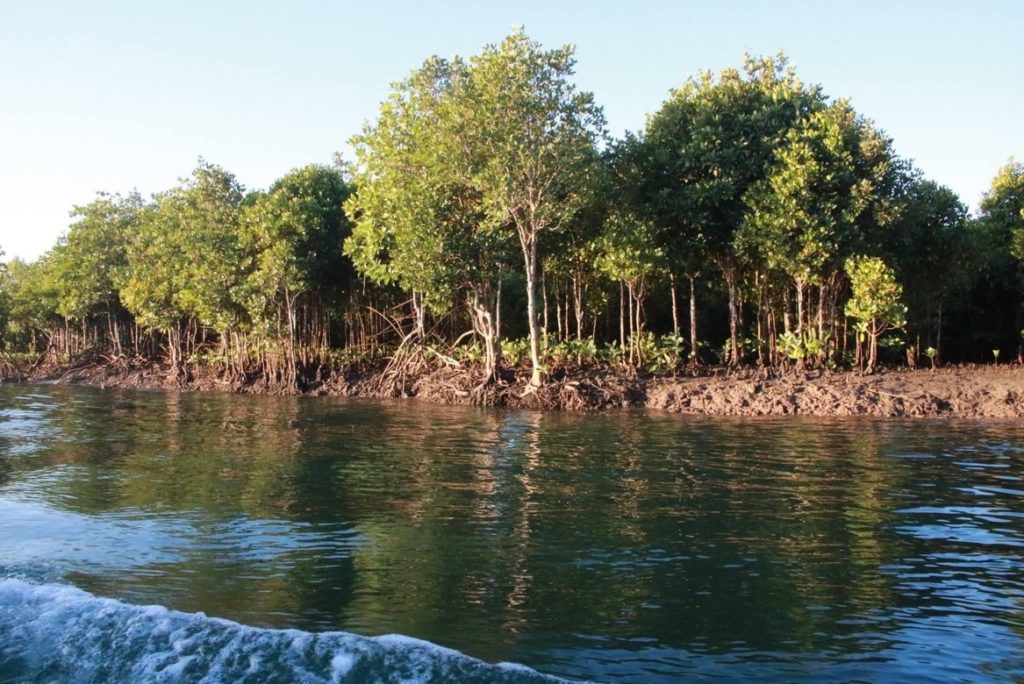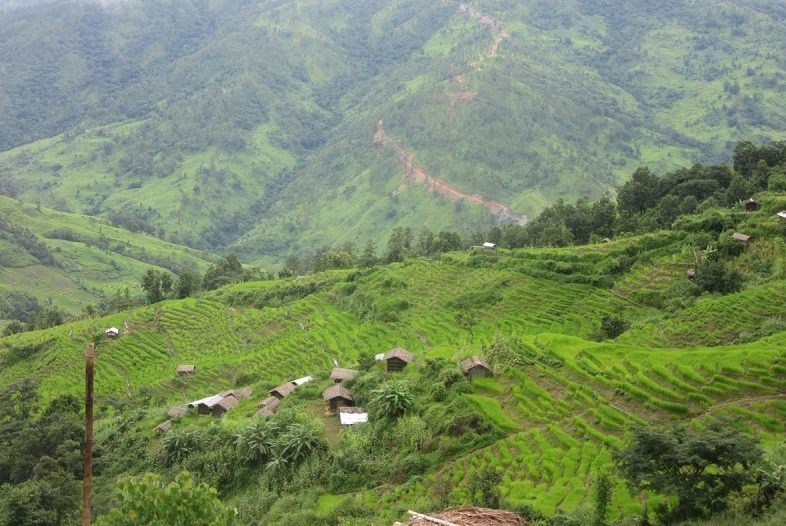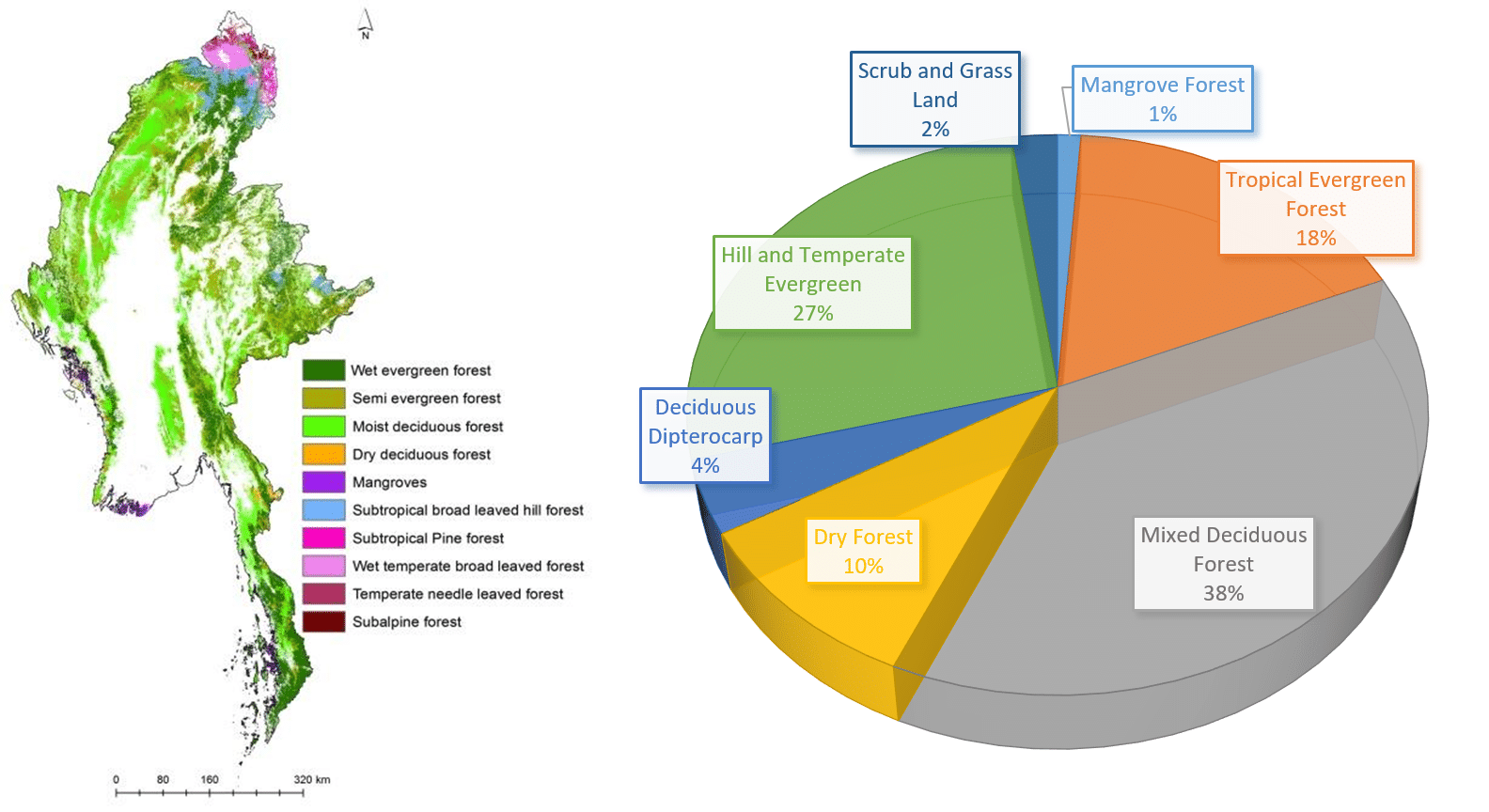1. Background
Myanmar is rich in natural resources thanks to its various types of forests and diverse biological resources. About 42.19% of the country’s land area is still covered by forest resources, accounting for 28.5 million hectares (FAO, 2020). Myanmar possesses great variation in topography and climatic conditions, and six major forest types can be found in the country, ranging from mangrove forests in the coastal region and dry forests and deciduous dipterocarp in the central region to hill and temperate forests in the northern part of the country (Figure 1). Of these, mixed deciduous forests and hill and temperate evergreen forests are the major forest types, covering an area of 38.20% and 26.92%, respectively (Figure 2). Myanmar’s forests play an important role in contributing to the nation’s economy and supporting the socio-economic and well-being of the local people. Over 70% of the country’s population resides in rural areas and mainly depend on forest resources for food, fodder, shelter, and fuel.

Mangrove forest in Myanmar
(Source: Climate Change Adaptation in Coastal Communities of Myanmar-FDCCA Project, Ministry of Natural Resources and Environmental Conservation)

(Source: Myanmar REDD+ Programme, Ministry of Natural Resource and Environmental Conservation)
2. Forest Classification
Under the management of the Forest Department, Myanmar’s forest area is being designated as Reserved Forest (RF), Protected Public Forest (PPF), and Protected Area (PA). The extent of PFE and PA is shown in Table 1.
- RF has the best quality and high commercial value but grants no harvesting rights to the public.
- PPF, with lower commercial value, is more accessible and grants some harvesting rights to the public.
- RF and PPF are collectively constituted as Permanent Forest Estate (PFE).
- Protected Area (PA) aims to preserve diverse ecosystems and the species richness of Myanmar.
Out of 46 PAs, the following eight PAs have been designated as ASEAN Heritage Parks (AHPs): Alaungdaw Kathapa National Park, Hkakabo Razi National Park, Indawgyi Wildlife Sanctuary, Inlay Lake Wildlife Sanctuary, Meinmahla Kyun Wildlife Sanctuary, Lampi Marine National Park, Natmataung National Park, and Htamathi Wildlife Sanctuary.
| Category | Total Number of Forest Plots | Total Area (hectares) | NFMP* Target for PFE & PA (% of country area by 2030) | Current Achievement (% of NFMP Target) |
|---|---|---|---|---|
| PFE (RF+PPF) | 1290 (RF – 848; PPF – 442) | 17,326,446 (RF – 12,017,240.5; PPF – 5,309,205.5) | 30% | 25.61% |
| PA | 46 | 4,121,496.25 | 10% | 6.09% |
*NFMP- National Forestry Master Plan (2000-01 to 2030-31)

(Right) Figure 2. Extent of Major Forest Types in Myanmar
3. Forest and Land Cover Changes
According to the FAO’s definition (FRA, 2020), forests can be categorized into areas of closed and open forest:
Closed forest means under forestry or no land use, spanning more than 0.5 hectares, with trees higher than 5 meters and a canopy cover of more than 40 percent, or trees able to reach these thresholds in situ. Open forest refers to under forestry or no land use, spanning more than 0.5 hectares, with trees higher than 5 meters and a canopy cover between 10 and 40 percent, or trees able to reach these thresholds in situ. Other wooded land means areas mostly covered by grassland and stunted trees, shrub forests, and lower than 10% crown density. Other land refers to all land that is not classified as “Forest” or “Other wooded land”.

Figure 3 shows that the forest area is gradually decreasing in Myanmar, while other land area is increasing gradually over time due to several causes. (Source: Forest Department, Myanmar, 2020 and FAO, 2020)
4. Drivers of Deforestation and Forest Degradation
Deforestation is “the conversion of forest land use into to non–forest land use” (i.e., 100% loss of Above Ground Biomass). Forest degradation is “the process of losing carbon stock from forest land, i.e. the land use remains forest, but the amount of carbon stock in the forest is reduced”. (Source: Myanmar REDD+ Programme – Forest Reference Emission Level (FREL) of Myanmar) Within the forestry sector, the main causes of deforestation and forest degradation include the overexploitation of timber (legal and illegal). over-extraction of fuelwood and charcoal, unstable shifting cultivation, forest fires, overgrazing, pests and diseases, and storms and landslides. Beyond the forestry sector, deforestation and forest degradation are mainly attributed to the expansion of agriculture (for subsistence and commercial uses), mining, infrastructure development, hydropower development, urbanization and resettlement, as well as aquaculture development. (Source: Myanmar REDD+ programme – Myanmar REDD+ Readiness Roadmap and Drivers of deforestation and forest degradation in Myanmar)

Deforestation and forest degradation are serious issues being tackled by most developing countries. Myanmar is the seventh-most deforested country in the world according to FRA-2020. The area of forest cover had decreased from 57.9 % of the country area in 1990 to 42.19% in 2020. The net annual forest area loss was 1.17% in 1990-2000, 1.03% in 2000-2010, and 0.96% in 2010-2020(FAO, 2020). The extent of forest cover changes in 10-years intervals from 1990 to 2020 is shown in Figure 4.
5. Policies, Legislations, and Strategic Action Plans in Myanmar
The following policies, legislations, instructions, and strategic action plans have entered into force in Myanmar for the sustainable management of forest resources, the protection, and conservation of natural biodiversity, and responding to climate change by mitigation and adaptation measures;
| No. | Years | Forest-focused policies, legislations and instructions |
|---|---|---|
| 1 | 1995 | Myanmar Forest Policy |
| 2 | 2012 | Environmental Conservation Law |
| 3 | 2014 | Environmental Conservation Rules |
| 4 | 2016 | National Land Use Policy |
| 5 | 2018 | Forest Law (Revision of 1992 Forest Law) |
| 6 | 2018 | Conservation of Biodiversity and Protected Areas Law (Revision of 1994 Protection of Wildlife and Protected Areas Law) |
| 7 | 2018 | Conservation of Biodiversity and Protected Areas Rules ( 2002 Protection of Wildlife and Protected Areas Rules) |
| 8 | 2019 | National Environmental Policy |
| 9 | 2019 | Myanmar Climate Change Policy |
| 10 | 2019 | Community Forestry Instructions (Revision of 1995 and 2016 Community Forestry Instructions) |
| 11 | 2019 | Forest Rules (Adds to and revises 1995 Forest Rules) |
| No. | Years | Forest-focused strategic action plans and national programs |
|---|---|---|
| 12 | 2001-2002 to 2030-31 | The National Forestry Master Plan |
| 13 | 2009 | National Sustainable Development Strategy for Myanmar |
| 14 | 2017-18 to 2026-27 | Myanmar Reforestation and Rehabilitation Programme |
| 15 | National REDD+ Strategy |
Core Essence of Policy, Legislation, and Instructions in the Forestry Sector of Myanmar
- Forest Law (2018) and Rules (2018, Drafted) Myanmar’s Forest Law, revised in 2018 based on the former Forest Law of 1992, is the main legal framework to achieve the effective implementation of the government’s forest policy and environmental conservation policy. It is also consistent with the international agreement. The new Forest Law covers the principles of sustainable forest management, while partly liberalizing property rights for timber, particularly teak, subject to ministerial instructions. It also aims to promote people’s participation in forest management while contributing to their basic needs. Currently, the government is drafting new Forest Rules. whichcurrently undergoing revision.
- Myanmar Forest Policy (1995) Achieving the national goals and aims of ensuring socio-economic development and stabilizing the environment and ecosystem, Myanmar Forest Policy (1995) was developed in an integrated and balanced manner, and its main six policy imperatives were set up as follows:
(1) Protection of soil, water, wildlife, biodiversity, and the entire environment;
(2) Sustainability of forest resources to ensure a perpetual supply of both tangible and intangible benefits accrued from forests for present and future generations;
(3) Basic needs of the people for fuel, shelter, food, and recreation;
(4) Efficiency to harness, in a socio-environmentally friendly manner, the full economic potential of forest resources;
(5) Participation of the people in the conservation and utilization of forests; and
(6) Public awareness about the vital role of forests in the well-being and socio-economic development of the nation. - National Land Use Policy (2016) To be systematic and harmonized in all land and tenure rights at the National level, Myanmar developed a National Land Use Policy in 2016. It will be the guiding document for the enactment of the National Land Law, which will harmonize existing land-related laws and solve issues related to land use and tenure rights among all relevant institutions.
- Conservation of Biodiversity and Protected Areas Law (2018) and Rules (2018, drafted) The Conservation of Biodiversity and Protected Areas Law was enacted in 2018, replacing the former law entitled Protection of Wildlife and Protected Areas Law (1994). The new law brings many more opportunities for recognizing the rights and potential roles of local communities while creating the new category of “Community Protected Areas.” It favors not only promoting co-management but also supporting international obligations such as the Convention on International Trade in Endangered Species of Wild Fauna and Flora (CITES). Penalties for legal infringement are more intense in the new law. The new Rules of Conservation of Biodiversity and Protected Areas are currently under revision, after being drafted in August 2018 for a second time.
- National Environmental Policy (2019) The National Environmental Policy was adopted in 2019. The policy builds on Myanmar’s 1994 National Environmental Policy and has three core values acknowledging preserving the environment and natural resources for present and future generations. The policy recognizes and integrates Myanmar’s commitments to multilateral environmental agreements, including the Paris Agreement.
- Myanmar Climate Change Policy (2019) The vision of the Myanmar Climate Change Policy adopted in 2019 is “sustainable, prosperous and inclusive, for the well-being of present and future generations.” The policy provides long-term direction and guidance to take and promote climate change action on adaptation and mitigation in Myanmar; and integrate climate change adaptation and mitigation considerations into Myanmar’s national priorities and across all levels and sectors in an iterative and progressive manner.
- Environmental Conservation Law (2012) and Rules (2014) The purpose of the Environmental Conservation Law adopted in 2012 is to implement the Myanmar National Environmental Policy, laying down basic principles and providing guidance for systematic integration of environmental conservation in the sustainable development process. This enables a healthy and clean environment to emerge and conserves natural and cultural heritage for the benefit of present and future generations.
Core Essence of the Strategic Action Plan and National Program Developed by the Forestry Sector of Myanmar
- National Forestry Master Plan (2001-02 to 2030-31) The National Forestry Master Plan (2001-02 to 2030-31) is the guiding element for forest management in Myanmar on a sustainable basis, as well as for meeting the sectoral target of the Forest Department, Myanmar. It provides strategic direction covering a wide range of forestry issues, including protection and conservation, reforestation and rehabilitation, production, and law enforcement. It also guided the fundamental framework for the ten-year forest management plan at the district level.
- Community Forestry Instructions (2019) Recognizing the important role of people’s participation in forest management, in line with the policy imperative “Participation of the people in the conservation and utilization of forests,” Myanmar launched Community Forestry Instructions (CFIs) in 1995 and amended them in 2016 and 2019. The new CF instructions (2019) pave the way not only for the provisions of local people’s basic needs but also for the commercialization of forest products while encouraging nature-based tourism for improving incomes and social welfare.
- National Sustainable Development Strategy for Myanmar (2009) The National Sustainable Development Strategy for Myanmar was adopted in 2009 with the vision of “Wellbeing and Happiness for Myanmar People.” This strategy has three main goals that deal with Goal 1: Sustainable Management of Natural Resources; Goal 2: Integrated Economic Development; and Goal 3: Sustainable Social Development.
- Myanmar Reforestation and Rehabilitation Programme (MRRP) (2017-18 to 2026-27) The Myanmar Reforestation and Rehabilitation Programme (MRRP) was launched by the Forest Department (FD) in 2017 with the aim of restoring degraded forest landscapes. This programme covers the national level by setting up targets for each region and state of the country, in cooperation with the Dry Zone Greening Department. The objectives of the programme are to restore and rehabilitate the degraded forests for climate change mitigation and adaptation as well as to enhance ecosystem services; meet the demand for teak and other commercial timber species; strengthen investment from the private sector in forest plantations; improve the livelihood and socioeconomic conditions of rural people by increasing job opportunities and through community forestry; and formulate the Forest Plantation Policy.
- National REDD+ Strategy [REDD+ refers to “Reducing Emissions from Deforestation and Forest Degradation, and the role of Conservation, Sustainable Management of Forest, and Enhancement of Forest Carbon Stocks in Developing Countries.”] The Myanmar REDD+ programme was initiated in 2012. It is currently taking rapid steps in REDD+ Readiness Phase I activities, while simultaneously initiating some pilot phase II activities, as the phases are not mutually exclusive. National REDD+ Strategy is a key element out of the four elements of the Warsaw Framework designated for REDD+ readiness activities — National REDD+ Strategy, National Forest Monitoring System (NFMS), Forest Reference Level (FRL), and Safeguards Information System (SIS). The goal of the Myanmar REDD+ Strategy is “to contribute to the achievement of a climate-resilient, low carbon, and sustainable development path of the country through transformational change in the land-use and forestry sector by reducing deforestation and forest degradation while enhancing livelihoods, sustainable growth, and development.” The strategy has been finalized through several multi-stakeholder consultations and technical meetings, and it specified the “policies and measures” (PAMs) that will be implemented to address priority drivers and overcome barriers to “+” activities.
6. AFoCO Projects in Myanmar
With the support of AFoCO, Myanmar’s Forest Department is currently implementing two projects that will contribute to the sustainable forest management of Myanmar as well as conformity with the strategic priority areas of AFoCO.
The project AFoCO/014/2020 entitled “Integrated Pest and Disease Management in Teak Plantations in Bago Region, Myanmar” is being implemented in the West Bago Yoma Region, particularly in the Pyay and Tharyarwaddy Districts. The project period is five years from 2020 to 2025. The main objective of the project is to contribute to healthy forests and the vitality of the West Bago Yoma Region through exploring pests and diseases and possible controls and measures while enhancing capacity-building programs for all stakeholders. The project also conforms with the AFoCO’s strategic priority areas of “Introducing systematic management on forest-related disasters” and “Supporting research and development in climate change adaptation approaches.”
The project AFoCO/015/2020 entitled “Model Forest for Livelihood Improvement of Forest Dependent Communities through Development of Community-based Enterprise and Forest Conservation in Myanmar” is being implemented in three townships: Ywangan and Pindaya Townships, Taungyi District, Southern Shan State and Paukkhaung Township, Pyay District, and Bago Region. The project duration is three years from 2020 to 2023. The project aims to balance forest conservation objectives with the livelihood improvement needs of the country, while also being in line with AFoCO’s strategic priority areas of “Initiating Customized Restoration and Reforestation model,” “Climate Change Adaptation” and “Local livelihood Improvement and Community-based Enterprise Development.”
References:
- Forest Department. 2020. Forestry in Myanmar. Forest Department, Myanmar.
- Food and Agriculture Organization of the United Nations[FAO]. 2020. Global Forest Resources Assessment 2020. Main Report. FAO, Rome. https://doi.org/10.4060/ca9825en.
- Food and Agriculture Organization of the United Nations[FAO]-Country Report of Myanmar. 2020. Global Forest Resources Assessment (FRA) 2020 Myanmar – Report (fao.org).
- Ministry of Natural Resources and Environmental Conservation, Myanmar and UN-REDD/Myanmar Programme. 2017. Drivers of Deforestation and Forest Degradation in Myanmar.
- Ministry of Natural Resources and Environmental Conservation, Myanmar. 2018. Forest Reference Emission Level (FREL) of Myanmar.
- The Republic of the Union of Myanmar. 2021. Nationally Determined Contributions.
- UN-REDD/ Myanmar Programme. Myanmar REDD+ Readiness Roadmap. 2013.
Contributed by Kay Khine, 2021 AFoCO Fellowship Official from Myanmar

